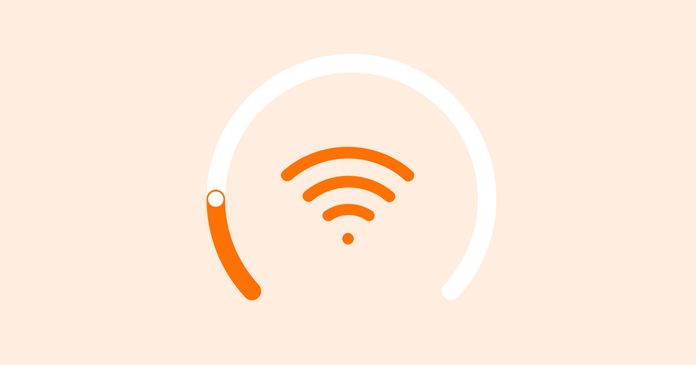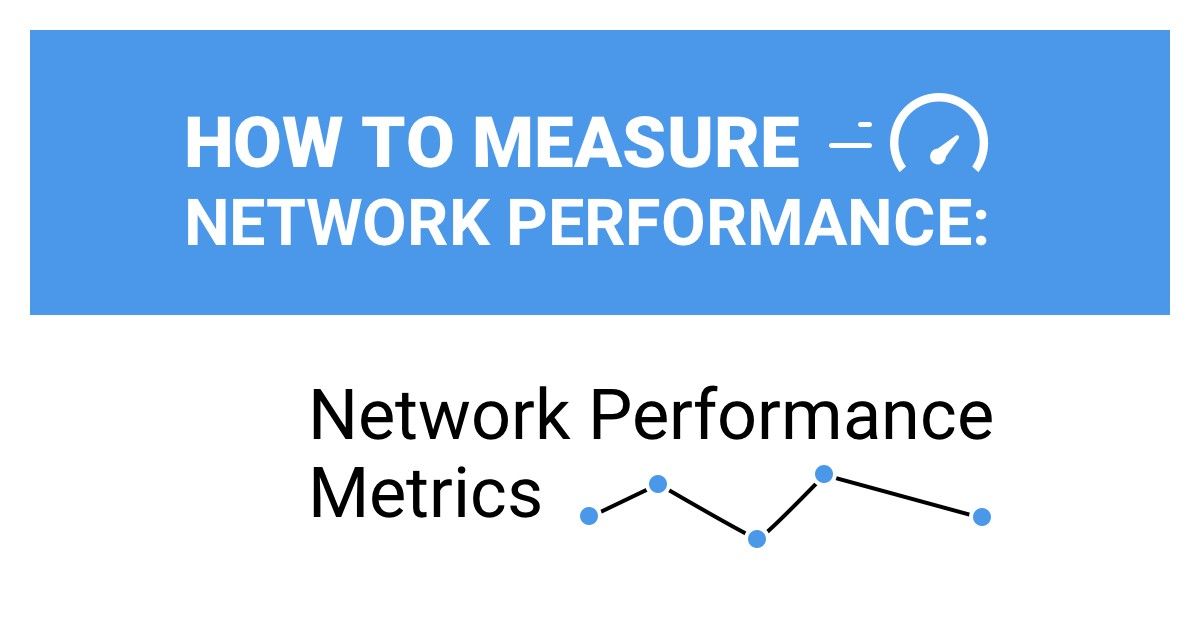Table of Contents
Table of Contents
Whether you're a small startup or a large enterprise, the ability to access and share information quickly and reliably is essential for productivity, customer satisfaction, and overall business performance. However, as networks become increasingly complex and interconnected, it's crucial for businesses to gain deep insights into their network utilization.
This blog post is your comprehensive guide to understanding the importance of monitoring network usage and the strategies that can help you optimize your network for enhanced performance, security, and cost-effectiveness. In an era where connectivity is paramount, this guide will equip you with the knowledge and tools necessary to make informed decisions that drive your business forward.
First, let’s go back to basics for a second.
Network utilization refers to the extent to which a computer network's resources, such as bandwidth, are being used at a given moment. It is a measurement of how much of the available network capacity is actively being used to transmit data, including traffic generated by applications, devices, or users.
The network utilization rate is the measure of how much of a network's available resources, such as bandwidth, processing capacity, or memory, are being actively used to transmit data.
Network utilization rate is typically expressed as a percentage, with 100% indicating that the network is fully saturated or overloaded with traffic and provides insights into how efficiently a network is operating.
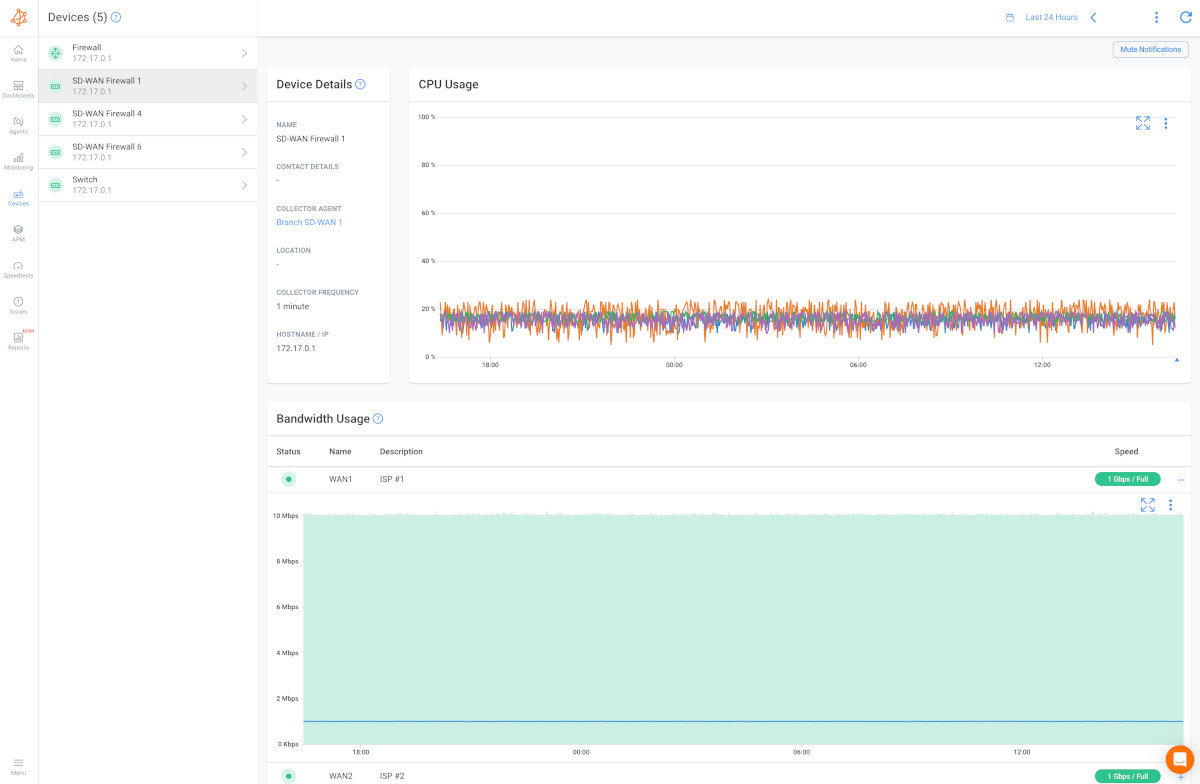

Network utilization is typically measured as a percentage and can be determined by analyzing network traffic data. There are several methods and metrics used to measure network utilization, including:
1. Bandwidth Utilization:
This metric calculates the portion of the available network bandwidth that is actively in use. It's often measured as a percentage, with 100% indicating that the network is fully saturated. The formula to calculate bandwidth utilization is:
Bandwidth Utilization (%) = (Traffic Volume / Total Available Bandwidth) * 100
- “Traffic Volume” represents the amount of data being transmitted over the network during a specific time period.
- "Total Available Bandwidth" is the maximum capacity of the network connection.
2. Interface Utilization:
This method focuses on individual network interfaces or ports on networking devices like switches and routers. It measures the usage of a specific interface by comparing the incoming and outgoing data rates. High utilization on a particular interface can indicate a potential bottleneck.
3. Network Flow Analysis:
Network flow analysis tools, like NetFlow or sFlow, collect data on network traffic flows, including details such as source and destination IP addresses, ports, and the amount of data transferred. By analyzing flow data, you can gain insights into which applications or services are consuming network resources and at what times.
4. Packet-Level Analysis:
This method involves examining individual network packets to determine how much data is being transmitted. While it provides detailed insights, packet-level analysis is often resource-intensive and may not be practical for the continuous monitoring of large networks.
5. Time-Based Monitoring:
Network utilization can vary throughout the day and week. Monitoring and analyzing utilization at different time intervals (e.g., hourly, daily, or weekly) can help identify patterns, peak usage times, and potential issues.
6. Traffic Classification:
By categorizing network traffic into different classes (e.g., voice, video, web, email), you can measure the utilization of each class independently. This approach is useful for ensuring that critical applications receive the necessary network resources.
7. Quality of Service (QoS) Metrics:
QoS metrics can be used to measure the performance and utilization of network services, especially in cases where guaranteed service levels are important. Metrics like latency, jitter, and packet loss can be indicators of network performance.
To measure network utilization effectively, businesses often use network monitoring and management tools that provide real-time or historical data on network traffic. These tools help network administrators track and analyze network utilization, identify trends, and make informed decisions about optimizing network performance, resource allocation, and capacity planning.
When it comes to ensuring the seamless performance of your network, you need a powerful and reliable tool that can provide real-time insights and proactive solutions. That's where Obkio comes in. With Obkio’s Network Monitoring tool, gain complete visibility into your network's utilization and performance, empowering your business to thrive in the digital age.

- Real-time Network Utilization Monitoring: Obkio's tool offers you the ability to monitor your network's utilization in real-time. Say goodbye to the guesswork and hello to data-driven insights.
- Proactive Issue Detection and Resolution: Don't wait for network issues to disrupt your operations. Obkio helps you detect problems before they impact your users, enabling you to take swift corrective actions.
- User-friendly Interface and Intuitive Reporting: Our platform boasts a user-friendly interface that makes it easy for you to access and understand critical network data. No need for a steep learning curve—start optimizing your network right away.
- Customizable Alerts: Stay in the know with customizable alerts tailored to your specific needs. Receive real-time notifications about critical network events to ensure you're always one step ahead.
- Scalable Solutions for Businesses of All Sizes: Obkio is designed to meet the network monitoring needs of businesses of every scale. Whether you're a small startup or a large enterprise, we've got a solution that fits your requirements.
Don't let network issues slow you down or compromise your business's success. Experience the power of Obkio's Network Monitoring tool, and be confident that your network is operating at its best.

For businesses reliant on high-functioning enterprise networks, monitoring network utilization is not merely an option—it's a fundamental necessity for organizations seeking to maintain a competitive edge.
So let’s dive into the critical importance of keeping a watchful eye on network utilization and explore the profound impact it has on the performance and success of your business operations.
As businesses increasingly rely on digital technology for their day-to-day operations, the network has evolved into a mission-critical component. Monitoring network utilization provides a window into your organization's connectivity, and understanding its implications is vital for strategic decision-making.
Here are some key business implications of network utilization:
- Productivity and Efficiency: High network utilization can lead to slow data transfer speeds, application lag, and increased latency. Employees' productivity can be hindered, affecting the overall efficiency of your workforce.
- Customer Satisfaction: For customer-facing businesses, network performance directly impacts the user experience. Slow-loading websites or buffering during video conferences can result in customer dissatisfaction and potentially lost sales.
- Operational Continuity: Many business-critical applications and services are hosted in the cloud. Inadequate network performance due to high utilization can disrupt these services, jeopardizing your organization's operational continuity.
- Competitive Advantage: In an environment where agility and responsiveness are crucial, a well-optimized network can give you a competitive edge. It ensures that your business can swiftly adapt to changing circumstances and technological advancements.
- Data Security and Compliance: High network utilization can affect the speed and effectiveness of security measures. Monitoring helps maintain robust cybersecurity by ensuring that security protocols work optimally.
Network utilization plays a pivotal role in determining the overall performance of your network infrastructure. The level of network utilization directly affects various aspects of network performance:
- Congestion: High utilization levels often lead to network congestion. When data traffic exceeds the available bandwidth, congestion occurs, causing data packets to be delayed or even dropped.
- Latency: Increased network utilization can result in higher latency, which impacts real-time applications like VoIP calls and video conferencing. Delays in data transmission can be frustrating for users and hinder the quality of service.
- Packet Loss: When the network is saturated, data packets may be lost. Packet loss can have a detrimental effect on data integrity, leading to retransmissions and inefficient data delivery.
- Bottlenecks: Network segments or devices with consistently high utilization can become network bottlenecks, limiting the flow of data. Identifying and addressing these bottlenecks is crucial for maintaining network performance.
Monitoring network utilization is not just about keeping an eye on data traffic; it's about ensuring your business operates smoothly, efficiently, and securely. It's about maintaining a competitive edge in a digital age where connectivity and performance are paramount. By understanding the business implications and the effects of network utilization on network performance, you are better equipped to make informed decisions and ensure the seamless operation of your business.
Learn how to detect network congestion & perform a network congestion test inside & outside your network with Network Monitoring & Network Device Monitoring.
Learn more

In today's digital landscape, the efficient operation of a computer network is a fundamental prerequisite for businesses of all sizes. Network utilization monitoring is the proactive approach to maintaining and optimizing network performance, and it forms the cornerstone of modern network management strategies.
So let’s explore what network utilization monitoring entails and the techniques employed to ensure the robust and efficient functioning of your network infrastructure.
Network utilization monitoring is the systematic process of continuously observing and analyzing the data traffic and resource consumption within a computer network.
This monitoring encompasses a wide range of activities, including the measurement of data transmission rates, bandwidth usage, and the types of traffic traversing the network. The primary goals of network utilization monitoring are to:
- Optimize Performance: By assessing the utilization of network resources, businesses can identify and rectify potential bottlenecks or congestion points, and optimize network performance.
- Improve Security: Monitoring network utilization helps detect unusual or unauthorized spikes in traffic, potentially signalling security breaches or cyberattacks. It plays a vital role in safeguarding network integrity.
- Plan Capacity: Understanding historical and real-time network utilization data is critical for network capacity planning. It enables organizations to allocate resources appropriately, ensuring the network can handle current and future demands.
- Control Costs: By monitoring utilization patterns, organizations can make informed decisions about bandwidth subscriptions, infrastructure investments, and other cost-related network management choices.
There are several techniques and methods used for effective network utilization monitoring, each offering unique advantages. These techniques provide network administrators with the necessary tools to gather and analyze data for better decision-making. Here are some key techniques for network utilization monitoring:
- Real-Time Network Utilization Monitoring: Real-time monitoring tools continuously capture and analyze data traffic, offering immediate insights into network performance and resource utilization. This technique is essential for identifying and addressing issues as they occur.
- Historical Data Analysis for Network Utilization: Examining historical network utilization data over time helps identify trends and patterns. It allows organizations to plan for future capacity requirements and make informed decisions based on long-term usage trends.
- Network Flow Analysis for Network Utilization: Flow analysis tools like NetFlow and sFlow collect data on network traffic flows, providing detailed information about data transmission, sources, and destinations. Flow analysis is vital for identifying the types of traffic that consume network resources.
- Quality of Service (QoS) Metrics for Network Utilization: QoS metrics focus on measuring the performance and utilization of specific types of network services. These metrics, such as latency, jitter, and packet loss, help ensure that critical applications receive the necessary network resources.
- Traffic Classification for Network Utilization: Categorizing network traffic into different classes (e.g., voice, video, web, email) allows organizations to monitor and control the utilization of resources by specific types of traffic.
By employing these techniques, network utilization monitoring becomes a robust practice that equips businesses with the data-driven insights needed to optimize network performance, enhance security, plan for future growth, and effectively manage network costs. In the ever-evolving world of network management, these techniques are indispensable for ensuring your network operates at its best.
Deploying network utilization monitoring is a strategic imperative for businesses seeking to optimize their network performance, enhance security, and control costs. One of the most effective methods for achieving this is by using a Network Monitoring tool.
Network Monitoring tools are designed to collect a wealth of data, including information on bandwidth usage, network traffic, resource consumption, and performance metrics. This comprehensive data collection is essential for gaining deep insights into your network's utilization.
They also offer real-time monitoring capabilities, allowing you to track network utilization as it happens. Real-time data is crucial for identifying and addressing network issues promptly before they impact users or applications.
So now, let’s get into the nitty-gritty details!
For businesses looking for an effortless, comprehensive way to monitor network performance and network utilization, Obkio's Network Performance Monitoring tool is the ultimate solution.
Obkio’s synthetic, end-to-end NPM tool revolutionizes the way you monitor, troubleshoot, optimize and assess your network performance and utilization. Using synthetic traffic to perform synthetic testing and simulate real-world network behaviour and user experiences, Obkio precisely measures network performance and critical network metrics.
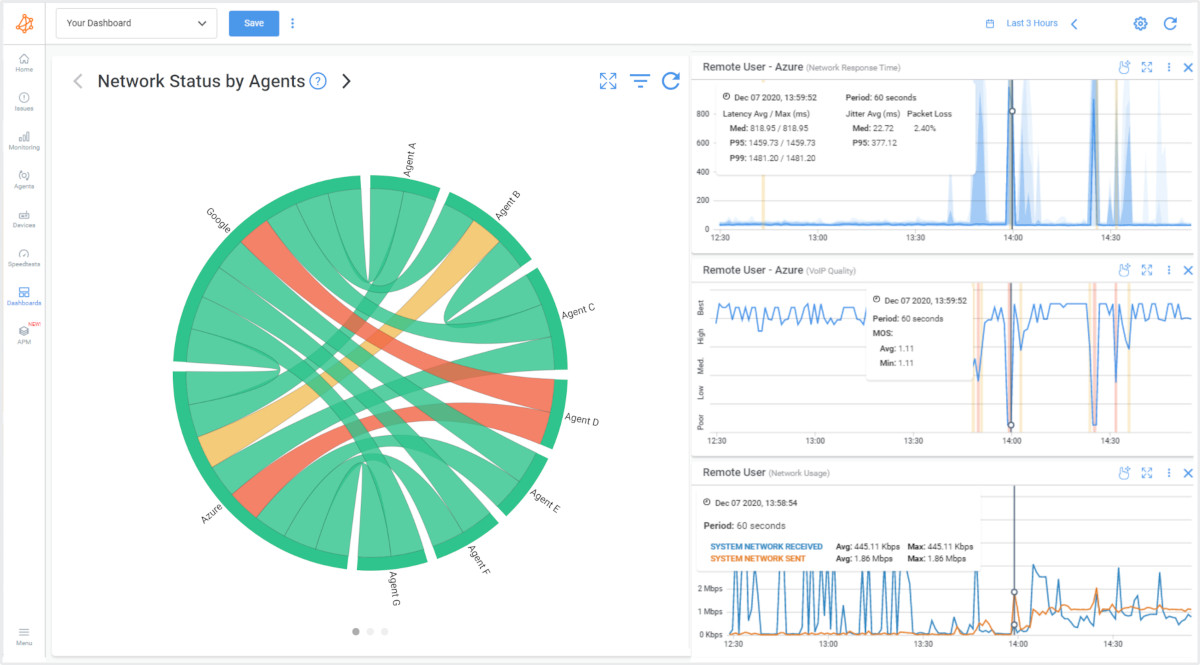
Deploying Network Monitoring Agents at different ends of your network, Obkio continuously exchanges synthetic traffic to continuously and proactively monitor network performance and utilization to help you quickly identify network issues. Say hello to effortless and precise network utilization measurements with Obkio's Network Performance Monitoring tool.

Obkio monitors network utilization and network performance and end-to-end network performance and uses continuous synthetic traffic from Network Monitoring Agents deployed in key network locations like offices, data centers and clouds.
For your end-to-end network utilization and performance monitoring setup, you’ll need the following Monitoring Agents (which Obkio’s Onboarding Wizard with help you deploy):
- Local Agents: Installed in the targeted office location where you want to monitor network utilization and network performance. There are several Agent types available (all with the same features), and they can be installed on MacOS, Windows, Linux and more.
- Public Monitoring Agent: These are deployed over the Internet and managed by Obkio. They compare performance up to the Internet and quickly identify if the problem is global or specific to the destination. For example, measure network utilization between your branch office and Google Cloud.
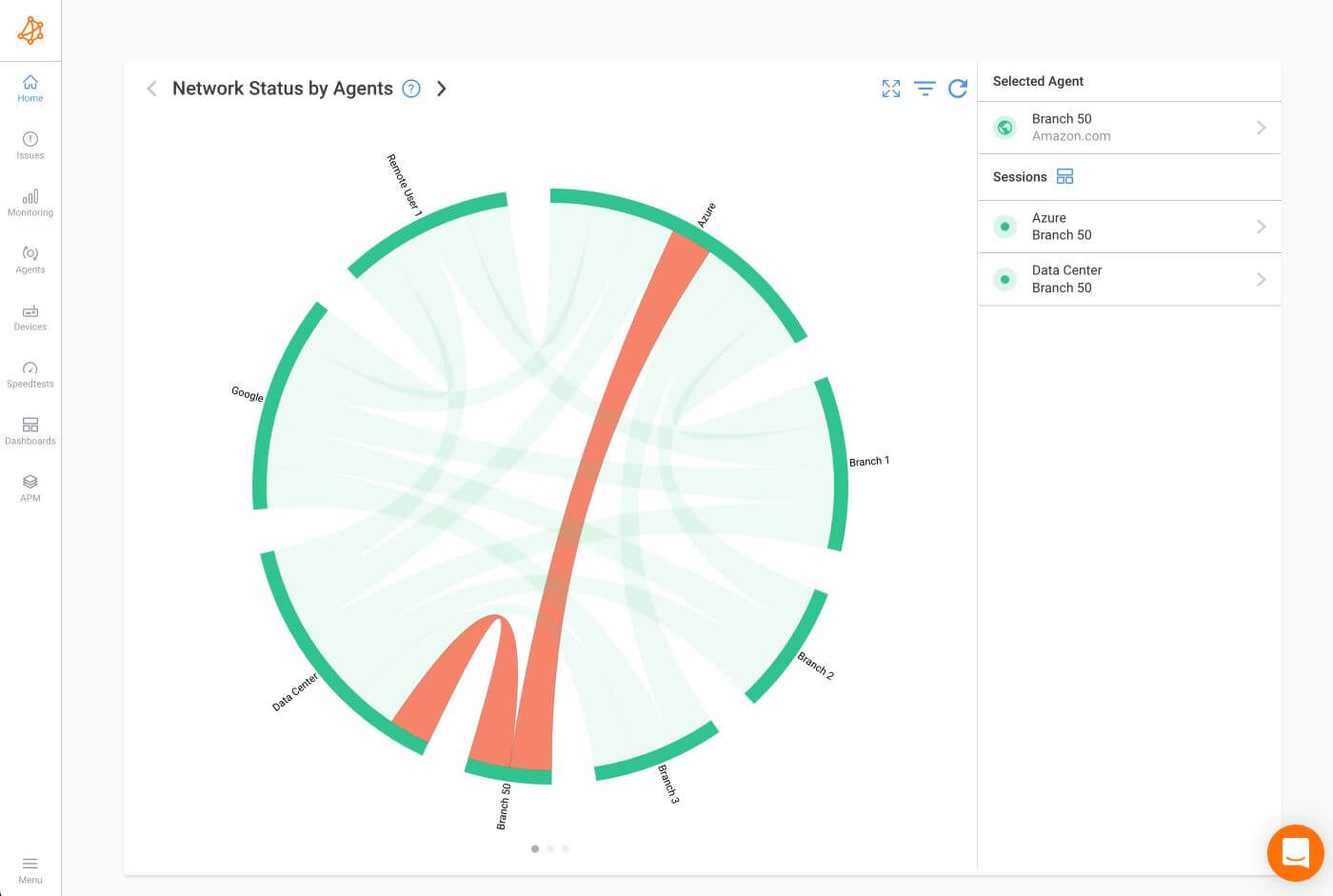
The Agents monitor network utilization, as well as other key network metrics in your network by sending and monitoring synthetic traffic through your network every 500ms for the most precise network performance measurements.
So when you’re looking to monitor network utilization with Obkio, make sure to activate Network Device Monitoring. It’s a fast and easy solution to get detailed information about the performance of your core network devices using SNMP polling to quickly and proactively pinpoint and troubleshoot network device issues like congestion, and high CPU and interface errors.
Network devices, such as routers, switches, firewalls, and access points, play a crucial role in the flow of data within a network. Monitoring these devices is essential for several reasons:
- Identifying Bottlenecks: Network devices can become bottlenecks when they are overwhelmed by traffic. Monitoring these devices helps pinpoint areas of congestion or performance degradation.
- Device Health: Monitoring network devices allows you to track the health and status of these critical components. It helps detect hardware or software issues that could affect network performance.
- Traffic Routing: Network devices determine how data packets are routed within the network. Monitoring them ensures that data is following the intended paths and adhering to routing policies.
- Resource Utilization: Network devices have their own utilization metrics, including CPU usage, memory consumption, and interface statistics. Monitoring these parameters can help identify resource-intensive processes and potential problems.
- Quality of Service (QoS): Many network devices support QoS features, which prioritize certain types of traffic over others. Monitoring QoS settings on devices helps ensure that critical applications receive the necessary resources.
- Configuration Changes: Monitoring network devices can alert you to unauthorized or unexpected configuration changes, which can have a significant impact on network performance and security.
- Capacity Planning: Understanding the utilization of network devices is essential for capacity planning. It helps in determining when hardware upgrades or additional devices are needed to accommodate network growth.
- Load Balancing: Some network devices, like load balancers, distribute traffic across multiple servers or paths. Monitoring load balancing ensures even distribution and efficient utilization of resources.
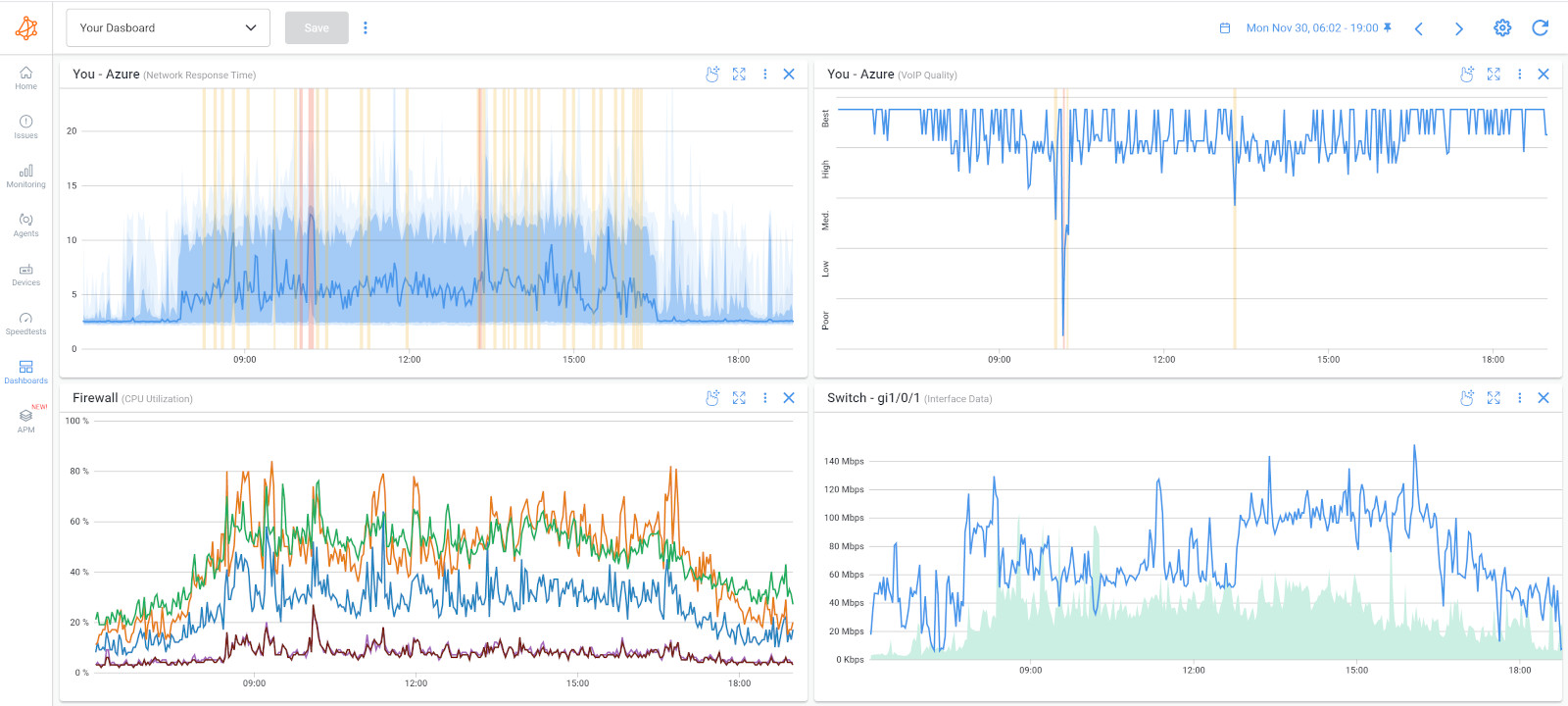
When monitoring network utilization, it is essential to consider other network metrics that affect network capacity and give you a complete understanding of network performance. These metrics provide valuable insights into various aspects of the network and help identify potential issues affecting network performance and utilization.
Lucky for you, Obkio measures a variety of other network metrics that impact network utilization and are essential to end-to-end network performance Here are some key network metrics to measure:
- Latency: Latency measures the delay in data transmission between source and destination. It's crucial for real-time applications like VoIP, video conferencing, and online gaming. Low-latency networks are important for maintaining responsive and efficient communication.
- Packet Loss Rate: Packet loss indicates the percentage of data packets that are lost or not successfully delivered. High packet loss can lead to retransmissions and degraded network performance.
- Jitter: Jitter is the variation in delay between data packets. For real-time applications, consistent jitter can lead to problems like voice call quality degradation. Monitoring and minimizing jitter is crucial for maintaining quality of service.
- Bandwidth Usage by Application: Understanding which applications consume the most bandwidth is important for network optimization and managing resource allocation. This helps identify bandwidth-hungry applications and potentially control their usage.
- Quality of Service (QoS) Metrics: QoS metrics, such as DSCP (Differentiated Services Code Point) or CoS (Class of Service), help prioritize certain types of traffic over others. Monitoring QoS settings ensures that critical applications receive the necessary resources.
- Availability and Uptime: Monitor network devices and servers for network availability and network uptime. Downtime can have significant business impacts, so it's crucial to track these metrics and ensure high availability.
- Capacity Planning: Tracking resource utilization on network devices, including CPU and memory usage, helps in capacity planning. It ensures that devices have sufficient resources to handle traffic loads.
- Application Performance Metrics: For applications hosted on the network, monitor application-specific performance metrics, such as response times, server load, and error rates. This helps ensure that applications are performing as expected.
- Remote Connectivity Metrics: If you have remote users or branch offices, Obkio’s remote network monitoring monitors connectivity and performance metrics for those locations to ensure they have a reliable and efficient connection to the main network.
- User Experience Metrics: For customer-facing businesses, measuring user experience metrics, like page load times and application response times, is essential for understanding the quality of service provided to end-users.
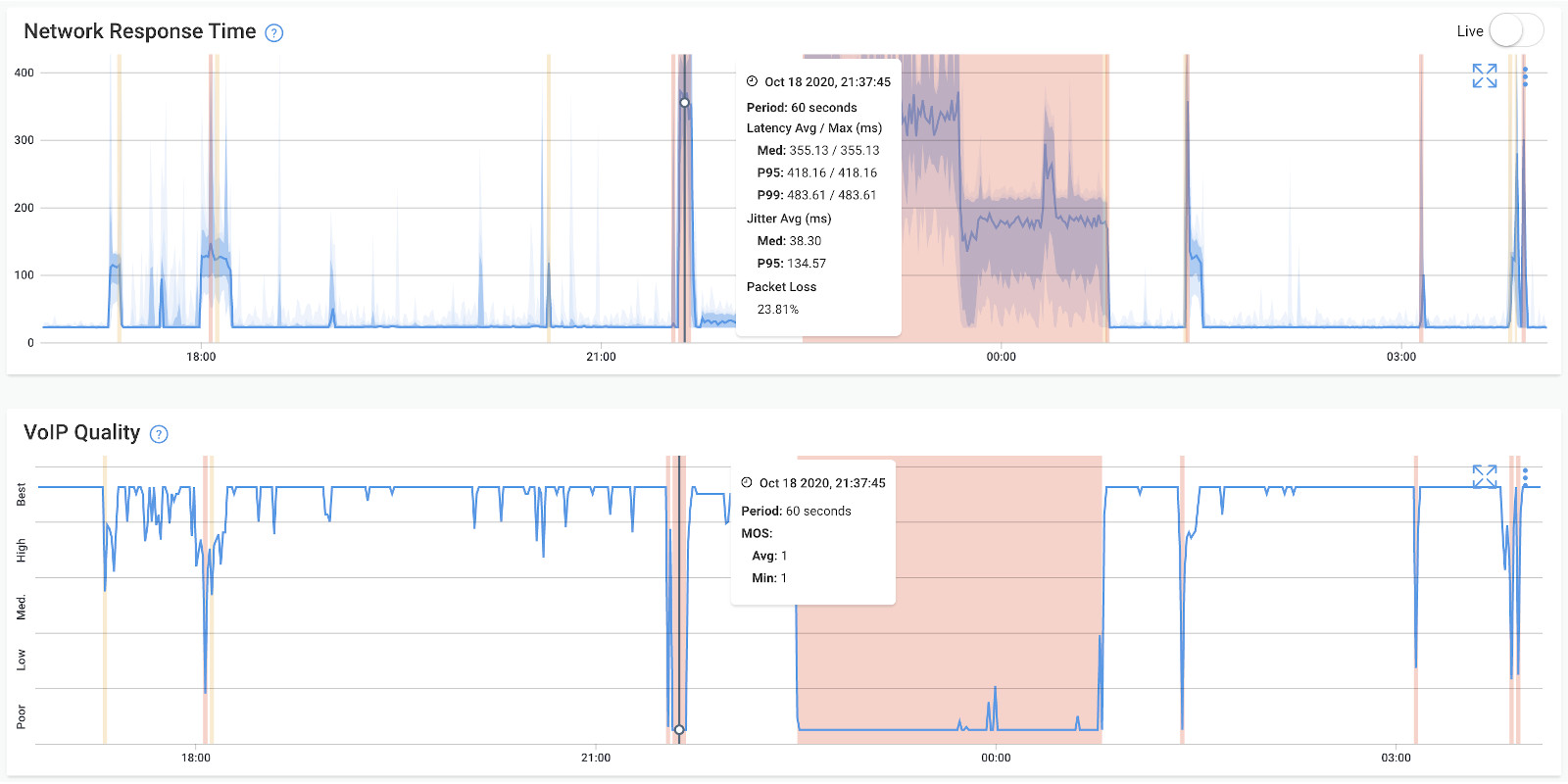
Obkio’s comprehensive network monitoring solution provides the ability to track multiple metrics simultaneously, allowing you to assess network performance from various angles and promptly respond to issues.
Step 5. Continuous Network Utilization Monitoring for Identifying and Troubleshooting Network Performance and Utilization Issues
Now that you know how to deploy Obkio for network performance and network utilization monitoring, it's time to introduce you to your new steadfast ally in network administration: Obkio. With its powerful capabilities and real-time insights, Obkio can become your permanent network administrator, ensuring continuous monitoring, seamless performance, and network optimization.
- Real-Time Data Collection: Continuous monitoring involves the real-time collection of data on network traffic, bandwidth usage, and device performance. This data provides immediate visibility into how your network is operating.
- Proactive Alerting: Obkio offers proactive network monitoring alerts to notify network administrators when predefined thresholds are exceeded. Alerts are crucial for taking swift action when issues arise.
- Data Analysis: Obkio’s SaaS app analyzes network performance data to identify patterns, anomalies, and trends. By tracking usage over time, it's easier to distinguish between normal fluctuations and actual issues.
- Historical Data: Historical data is valuable for capacity planning, trend analysis, and identifying long-term usage patterns. Obkio’s Network Monitoring tool stores historical data that can be accessed for analysis and reference.
The Benefits of Continuous Network Utilization Monitoring:
- Immediate Issue Detection: Continuous monitoring allows for the rapid identification of network issues. When high utilization, congestion, or performance bottlenecks occur, administrators are promptly alerted, enabling them to address issues before they escalate.
- Proactive Troubleshooting: With real-time data at your disposal, you can proactively troubleshoot network performance problems. Instead of reacting to user complaints, you can identify and address issues before they impact users or applications.
- Optimization of Resources: By tracking resource utilization, administrators can ensure that network resources are allocated efficiently. This includes bandwidth allocation, load balancing, and capacity planning to prevent resource shortages.
- Improved User Experience: Reliable network performance ensures that users have a positive experience when accessing applications and services. Continuously monitoring network utilization helps maintain quality of service and responsiveness.
In a nutshell, keeping an eye on your network with continuous utilization monitoring is like having a vigilant friend who's always got your back. It's all about staying ahead, making sure your network performs like a champ, and keeping it secure. With Obkio's continuous Network Monitoring tool on your side, you're in the driver's seat. It's your go-to for spotting and tackling any hiccups in network performance, managing your resources smartly, and making sure your network services shine bright.


When you’re monitoring and measuring network utilization, it’s important to understand what percentage of network utilization is considered optimal for your network.
The perception of good vs. bad network utilization can vary based on the specific requirements and goals of an organization or the context of a network. What's considered "good" or "bad" network utilization depends on factors such as the type of network, its intended use, and the quality of service expected.
However, here are some general guidelines:
- Low to Moderate Utilization: In most cases, having network utilization in the range of 30-70% is considered a good network utilization rate. This allows room for occasional spikes in traffic without causing performance degradation.
- Steady and Predictable: A network with consistent and predictable utilization is generally considered good. Unpredictable spikes can lead to congestion and degraded performance.
- Adequate Requirements: Good network utilization meets the requirements of the organization without causing congestion or slowdowns. It ensures that critical applications and services perform without interruption.
- Efficient Use of Resources: A good network efficiently utilizes available bandwidth, ensuring that it's not underutilized but also not overburdened.
- Proactive Monitoring: A network that is actively monitored and adjusted to maintain optimal performance is usually considered good. Network administrators can address issues before they impact users.
- High and Sustained Utilization: Consistently high utilization, close to or at 100%, is often considered bad. It indicates that the network is fully saturated and can lead to congestion and performance issues.
- Unpredictable Spikes: Frequent and unpredictable spikes in utilization can be problematic, especially if they cause congestion during critical times.
- Bottlenecks: Network segments or devices with consistently high utilization that become bottlenecks are problematic. Data packets might be delayed or dropped.
- Resource Saturation: A network that's consistently operating at or near its maximum capacity is considered bad. It leaves no room for growth or handling unexpected surges in traffic.
- Negatively Impacting Critical Services: High utilization that negatively impacts critical services like VoIP, video conferencing, or database access is generally bad. It can result in poor user experience and business disruptions.
- Frequent Errors and Packet Loss: High utilization that leads to an increased network error rate or packet loss is a sign of a network under stress and is considered bad.
A network is said to be at 100% utilization when all available network resources, such as bandwidth and network capacity, are fully consumed by data traffic. In other words, when a network is operating at 100% utilization, it is handling the maximum amount of data traffic it can support, and there is no additional capacity available for use.
A network operating at 100% utilization is effectively saturated. When a network reaches this point, several potential issues can arise:
- Congestion: Network congestion (WAN or LAN congestion) occurs when there is more data traffic than the network can handle. This leads to delays in data transmission, data packet loss, and a decrease in overall network performance.
- Latency: With high utilization, latency (the time it takes for data to travel from source to destination) often increases. High latency can be particularly problematic for real-time applications like VoIP and video conferencing, as it can lead to delays and reduced call quality.
- Packet Loss: When a network is fully utilized, data packets may be dropped or lost due to congestion. This can result in incomplete data transmission and the need for retransmissions, further impacting performance.
- Bottlenecks: Specific network segments or devices may become bottlenecks, as they are handling more traffic than they can effectively process. This can lead to localized network performance issues.
- Degraded Quality of Service: High network utilization can lead to a decreased quality of service, affecting the performance and reliability of applications and services.
100% network utilization means that the network is operating at its maximum capacity, and it can result in performance degradation, congestion, and other issues. It's generally not desirable for a network to operate at 100% utilization, as it leaves no room for handling unexpected surges in traffic or accommodating growth.
How to measure bandwidth, identify issues & optimize network performance. Use Obkio's Network Performance Monitoring tool for easy bandwidth monitoring.
Learn more

Poor network utilization can affect various parts of the network, often leading to performance issues and disruptions. The specific parts of the network most affected by poor network utilization can include:
- Network Interfaces: Network interfaces on routers, switches, and other devices can be heavily impacted by poor network utilization. High utilization can lead to increased packet drops and delays, degrading the performance of these devices.
- Network Links and Connections: Network links, such as Ethernet connections, can suffer from poor network utilization, resulting in congestion and a decline in data transmission speeds. Inefficient use of network links can lead to slow data transfer and packet loss.
- Switches and Routers: Switches and routers are critical network components. Poor utilization can lead to inefficiencies in data routing and switching, causing bottlenecks and delays in data transmission.
- Firewalls and Security Devices: Network security devices, including firewalls and intrusion detection systems, can be overwhelmed by high network utilization, potentially leading to reduced security effectiveness and the risk of security breaches.
- Load Balancers: Load balancers distribute traffic across multiple servers or paths to ensure even resource utilization. Poor network utilization can affect the performance of load balancers, leading to uneven distribution and potential overloading of specific resources.
- VoIP and Unified Communications: Real-time communication systems, such as VoIP and unified communications platforms, are highly sensitive to network utilization issues. Poor utilization can result in dropped calls, audio or video quality degradation, and latency.
- Cloud Services and Data Centers: Poor network utilization can impact data centers and cloud services, leading to reduced performance and efficiency in delivering applications and services hosted in these environments.
- End-User Devices: Poor network utilization can also affect individual devices connected to the network, including computers, smartphones, and IoT devices. Users may experience slower internet access or reduced performance when trying to access applications or web services.
- Quality of Service (QoS) Settings: Poor network utilization can challenge QoS settings, making it difficult to ensure that critical applications receive the necessary resources and maintain a high quality of service.
- Network Monitoring Systems: Even network monitoring systems themselves can be impacted by poor utilization, affecting their ability to collect and report on network performance metrics accurately.
- Remote Offices and Branches: Poor network utilization can hinder network performance at remote offices and branch locations, affecting the connectivity and user experience for remote users.
It's important to note that the specific areas affected by poor network utilization can vary depending on the nature of the network, the network's architecture, and the severity of the utilization issues.
It's also important to note that what's considered "good" or "poor" can vary based on the specific goals and requirements of an organization. For example, in some cases, a network designed for redundancy and over-provisioning may tolerate higher levels of utilization without issues.
When you’re monitoring your network utilization, you may discover that your network utilization is higher than it should be.
High network utilization is a situation where a network's available resources, such as bandwidth and processing power, are being fully or nearly fully utilized. This section delves into what high network utilization entails, explores common causes, and provides insights into addressing and monitoring this situation.
High network utilization occurs when a network is operating at or near its maximum capacity. In this state, data traffic and resource consumption are at peak levels, often resulting in congestion (WAN or LAN congestion), performance degradation, and potential network issues. High network utilization can be indicative of a network operating at its limit, where additional traffic may lead to problems.
Several factors can contribute to high network utilization:
- Increased Data Traffic: A surge in data traffic due to factors such as a sudden influx of users, a spike in usage of data-intensive applications, or increased demand for network services can lead to high utilization.
- Inadequate Network Capacity: Insufficient network capacity relative to demand can result in high utilization. Inadequate bandwidth, processing power, or memory can cause network resources to be overwhelmed.
- Inefficient Routing: Inefficient data routing or suboptimal paths can contribute to high utilization. Traffic may take longer, indirect routes, causing congestion and slowing down data transmission.
- Security Incidents: Security breaches or cyberattacks can lead to high network utilization as malicious traffic floods the network in attempts to breach security measures or disrupt services.
- Ineffective Resource Management: Poor resource management, such as failing to allocate sufficient bandwidth for critical applications or failing to prioritize traffic effectively, can result in high utilization.
Troubleshooting and reducing high network utilization is essential for maintaining network performance and minimizing the risk of congestion, disruptions network disconnections. Here are some tips:
- Upgrade Network Capacity: If high utilization is due to inadequate capacity, consider upgrading network resources. This may involve increasing bandwidth, adding more network devices, or expanding data center capabilities.
- Optimize Traffic Routing: Implement efficient routing protocols to ensure that data takes the most direct and efficient paths through the network. This can help reduce congestion and improve resource utilization.
- Prioritize Critical Traffic: Implement Quality of Service (QoS) settings to prioritize critical applications and services, ensuring they receive the necessary network resources even during periods of high utilization.
- Load Balancing: Implement network load balancing solutions to distribute traffic evenly across network resources, preventing any single device or path from becoming overloaded.
- Security Measures: Implement robust security measures to prevent and mitigate security incidents that can lead to high network utilization. Firewalls, intrusion detection systems, and traffic analysis can help.
- Monitor and Alerting: Implement continuous network monitoring and alerting systems to detect and respond to high utilization in real time. Alerts can prompt proactive action to address the issue.
- Capacity Planning: Regularly review and update capacity planning to ensure that your network can handle increasing demands and traffic spikes.
In summary, high network utilization can result from factors like increased traffic, insufficient capacity, or inefficient resource allocation. But, by proactively managing high utilization, you can maintain network performance and minimize the risk of congestion and disruptions.
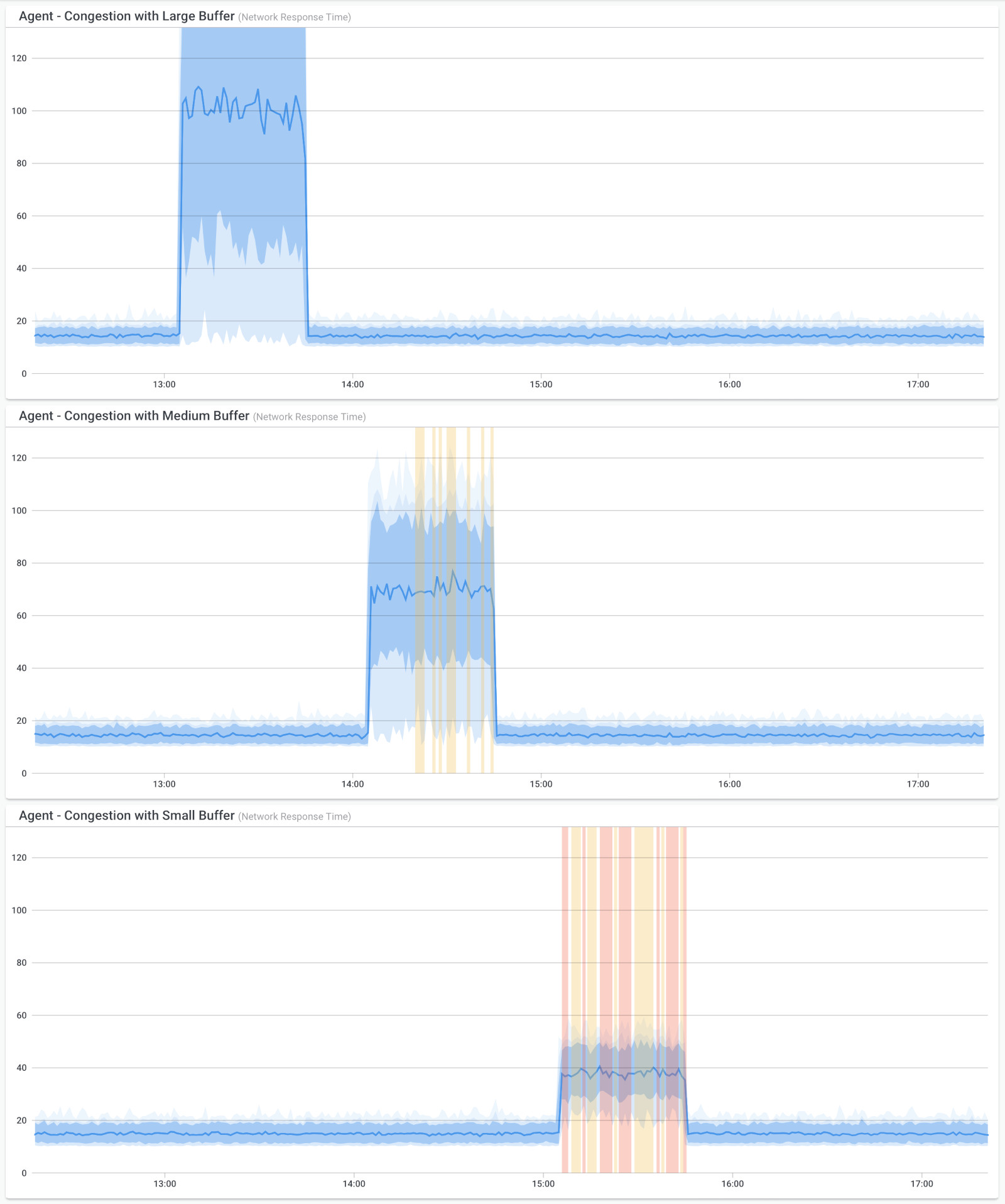

Low network utilization, while seemingly less concerning than high utilization, can impact network efficiency and resource allocation. This section delves into what low network utilization entails, explores the common causes, and provides insights into rectifying this situation.
Low network utilization refers to a scenario in which a network is not effectively using its available resources. In such cases, the network is underutilized, and significant portions of its capacity, such as bandwidth, processing power, or memory, remain unused. Low network utilization can lead to inefficient resource allocation and underperformance in the network.
Several factors can contribute to low network utilization:
- Overprovisioning: Overprovisioning is a common cause of low utilization. It occurs when network resources are allocated in excess of actual requirements. This can happen when businesses plan for future growth that has not yet occurred, resulting in underutilized resources.
- Underutilized Applications: If specific applications or services do not use the full capacity of the network, it can lead to low utilization. For example, a VoIP system with few active calls may not fully utilize the available bandwidth.
- Inefficient Routing: Inefficient routing of data can lead to low utilization. Data may take suboptimal paths through the network, resulting in underutilization of available resources.
- Idle Devices: Devices that are connected to the network but not actively transmitting data can contribute to low utilization. For instance, computers in sleep mode or devices on standby can consume network resources without actively utilizing them.
- Resource Allocation Policies: Misconfigured Quality of Service (QoS) policies or restrictive bandwidth allocation can artificially limit the utilization of network resources.
Addressing low network utilization is essential for optimizing resource allocation and network performance.
- Reevaluate Resource Allocation: Review your resource allocation policies and adjust them to better match actual network requirements. Remove overprovisioned resources that are not being fully utilized.
- Optimize Application Usage: Examine application usage patterns and adjust settings or allocate resources based on actual demand. Ensure that critical applications receive the resources they need for optimal performance.
- Improve Routing Efficiency: Implement efficient routing protocols to ensure that data takes the most direct and efficient paths through the network. This can help maximize resource utilization.
- Monitor Device Activity: Identify and address idle or underutilized devices on the network. Ensure that devices actively contribute to network utilization. As we mentioned earlier, you can use Obkio’s Network Device Monitoring feature to do so.
- Review QoS Settings: Evaluate your QoS settings and ensure that they align with your network's requirements. Adjust QoS policies to prioritize critical applications and services, such as QoS for VoIP.
- Regularly Audit Network Performance: Continuously monitor network performance, including utilization. Regular network audits can help identify and address low network utilization as it occurs.
- Capacity Planning: Implement effective capacity planning strategies to accommodate future growth and prevent overprovisioning or underutilization of resources.
Low network utilization can result from a variety of factors, including inefficient resource allocation, application underutilization, and routing inefficiencies. To fix low network utilization, it's crucial to reevaluate resource allocation while monitoring network performance to maintain an ideal balance between resource capacity and demand. This will lead to a more efficient and well-utilized network infrastructure.
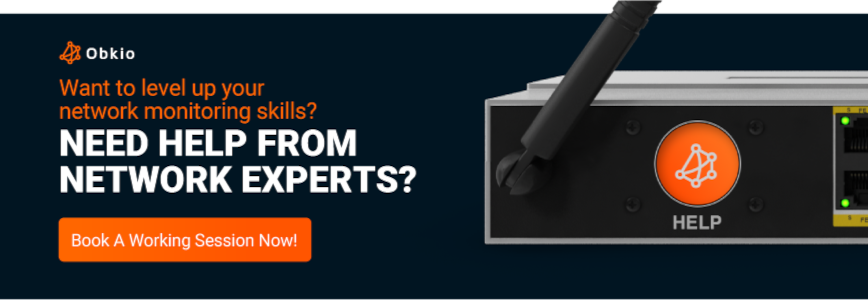
Determining the optimal level of network utilization for your network involves a combination of factors, and there's no one-size-fits-all answer because it depends on your specific business needs, goals, and the nature of your network.
Network utilization can affect so many different aspects of your business and your network, so, as your business grows, it’s important to understand what is your network’s capacity, and how much of that can be utilized.
Here’s a step-by-step process to help you assess and determine the optimal network utilization for your organization:
1. Understand Your Business Requirements:
- Start by understanding your organization's business requirements. What applications and services are essential to your operations? What are your performance expectations for these critical functions?
- Identify which network-dependent tasks are mission-critical and require consistent, high-performance network access.
2. Identify Your Network's Purpose:
- Determine the primary purpose of your network. Is it primarily for internal communication, accessing cloud services, serving customers, or a mix of these and more? Your network's role will impact its utilization requirements.
3. Set Performance Benchmarks:
- Establish clear performance benchmarks based on your business objectives. For example, if you run an e-commerce platform, you might set a benchmark for web page load times.
- These benchmarks will help you define the expected level of performance and identify network utilization thresholds.
4. Analyze Historical Data:
- Examine historical network utilization data to understand the network baseline and identify trends. Continuous monitoring tools can help provide this data.
- Look for patterns related to time of day, day of the week, or specific events that affect network usage.
5. Consider Scalability:
- Take into account the scalability of your network. If your organization is growing, your network utilization requirements will change. Plan for scalability to accommodate future needs.
6. Consult with Network Users:
- Collaborate with network users and department heads to gain insights into their network requirements. They can provide valuable input on the performance levels they need to meet their responsibilities.
7. Set Utilization Thresholds:
- Establish utilization thresholds that align with your business objectives. These thresholds will guide your monitoring efforts and trigger alerts when exceeded.
8. Perform Periodic Audits:
- Conduct periodic network audits to ensure that the utilization levels align with your business requirements and benchmarks. Adjust thresholds if needed.
9. Balance Resource Allocation:
- Strive for a balanced resource allocation strategy. Ensure that critical applications receive the necessary bandwidth and prioritize traffic accordingly. Quality of Service (QoS) settings can help achieve this balance.
10. Regularly Review and Adjust:
- Network utilization is not static. Continuously review your network's performance against your benchmarks and objectives. Adjust thresholds and network resources as necessary to maintain optimal performance.
Ultimately, the level of optimal network utilization is highly contextual and should align with your business goals, the nature of your operations, and the performance expectations of network-dependent applications and services. Continuously monitoring and adapting your network utilization is key to maintaining an optimal and efficient network environment.
Learn how to perform a network audit (network performance audit) to uncover issues before they cause havoc. Uncover Obkio's Network Audit Tool.
Learn more

Now that we've reached the end of this article, we want to leave you with some best practices to empower you in the world of network utilization. The health and performance of your network are crucial to the success of your business, and adopting these best practices will help you ensure that your network operates efficiently and consistently.
From continuous monitoring to traffic prioritization, these strategies will be your trusted companions in the journey to network optimization. Let's dive into the world of best practices for a network that's not just connected, but finely tuned.
- Continuous Network Monitoring: Implement continuous network monitoring tools, like Obkio, to track network performance and utilization in real time. This allows you to quickly identify and address issues before they impact users.
- Traffic Prioritization (Quality of Service - QoS): Implement QoS policies to prioritize critical applications and services over less important traffic. Ensure that important traffic receives the necessary resources even during periods of high utilization.
- Load Balancing: Use load balancing solutions to distribute traffic evenly across network resources. This helps prevent specific devices or paths from becoming overloaded, improving overall network utilization.
- Optimize Routing: Implement efficient routing protocols to ensure that data takes the most direct and efficient paths through the network. Reducing unnecessary detours can alleviate congestion.
- Bandwidth Management: Allocate bandwidth based on the specific needs of applications and services. Adjust bandwidth allocation to match the importance of the data they handle.
- Capacity Planning: Regularly review and update capacity planning to ensure that your network can handle increasing demands and traffic surges. This helps prevent resource shortages and bottlenecks.
- Resource Allocation: Ensure that network devices have the necessary resources, including CPU and memory, to handle traffic loads. Upgrade or expand resources as needed.
- Efficient Network Design: Plan and design your network with efficiency in mind. Minimize long-distance data transmission and reduce unnecessary hops.
- Regular Audits: Conduct regular network audits to identify and address utilization issues. Review your network's performance and make adjustments as necessary.
- Cloud Services Optimization: Optimize the utilization of cloud services by dynamically adjusting resources to match actual usage. Take advantage of auto-scaling features provided by cloud providers.
- Content Delivery Networks (CDNs): Use CDNs to offload traffic and deliver content from servers that are geographically closer to users, reducing the load on your network.
By implementing these network monitoring best practices, you can effectively optimize network utilization, enhance network performance, and ensure efficient resource allocation within your organization's network environment.
In conclusion, network utilization monitoring isn't just a piece of the puzzle; it's the cornerstone of network management for businesses. It safeguards reliability, resource efficiency, cost-effectiveness, user satisfaction, and proactive problem-solving.
Network utilization monitoring is far more than a technical endeavour; it's a strategic necessity for businesses operating in today's interconnected landscape. Here's what it all comes down to:
- Reliability: Businesses rely on dependable network performance. Monitoring network utilization is the key to upholding reliability and ensuring that your network aligns with your business's operational demands.
- Efficient Resource Allocation: With accurate utilization data in hand, you can allocate resources effectively. This means that critical applications receive their required bandwidth, and non-essential traffic doesn't needlessly consume resources.
- User Experience: User experience is the linchpin of your relationships with clients, customers, and employees. A well-monitored and optimized network guarantees a seamless experience when interacting with applications and services.
- Proactive Issue Resolution: Network utilization monitoring empowers you to preemptively address issues before they disrupt users. Proactive issue resolution not only minimizes disruptions but also saves you valuable time and resources.
In your pursuit of network optimization, Obkio’s Network Monitoring tool serves as your reliable ally, providing the real-time insights and capabilities essential to maintain your network's peak performance and alignment with your business objectives. It's all about empowering your network for resounding success in the dynamic landscape of modern business.

Put It to the Test: Trying Is the Ultimate Way to Learn!
Networks may be complex. But Obkio makes network monitoring easy. Monitor, measure, pinpoint, troubleshoot, and solve network problems.
- 14-day free trial of all premium features
- Deploy in just 10 minutes
- Monitor performance in all key network locations
- Measure real-time network metrics
- Identify and troubleshoot live network problems

You can rest assured that we're not like those pushy salesy people - there's no catch here. We firmly believe in the excellence of our product, but if it's not the right fit for you, we understand and want what's best for you.


























 Obkio Blog
Obkio Blog






